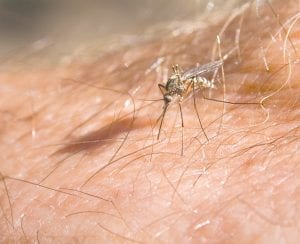Wildlife scientists are in the process of trying to determine whether mosquitoes are carrying the Eastern Equine Encephalitis virus to Minnesota’s moose population. They will begin mosquito trapping in June and shouldn’t have too much trouble finding the pesky little buggers. Results of the research won’t be known until next fall or winter when they can study the mosquito corpses in a lab.

North America’s largest herbivore— Minnesota’s moose—may be the victim of a disease carried by one of Minnesota’s smallest—albeit peskiest creatures the wily (whiny) mosquito.
Moose have suffered huge losses in population the last 10 years. More than half of the herd had died out, and scientists have been scrambling to figure out why.
They might now have one more part of the puzzle. One of Minnesota’s smallest predators, the mosquito, might be carrying eastern equine encephalitis (EEE), or, as Erika Butler, DVM, wildlife veterinarian of the Minnesota Department of Natural Resources (DNR) says, “What I like to describe as West Nile Virus’ evil sister.”
Butler said the DNR is starting mosquito trapping throughout Minnesota this spring.
“The reason we are doing this is because we did some hunter harvested moose disease surveillance and came up with some moose that tested positive to eastern equine encephalitis. Until we got these results we didn’t even know that we had EEE in that portion of the state.
“Additionally, we aren’t sure what sort of impact this disease could be having on our moose population, and we’d like to know more about distribution on the landscape,” Butler said.
The decline for moose in northeastern Minnesota has been steady. Since 2006, the moose population has fallen from an estimated 8,840 moose to an estimated 4,230 this spring.
In northwestern Minnesota it has been far worse. In 1980 there were more than 4,000 moose, today there are fewer than 20 left.
Researchers have looked at predation, disease, food supplies, and stress caused from warming temperatures in the region as causes for the rapid decline in moose. So far, no one thing has stood out, so scientists keep looking, and maybe mosquitoes are carrying the problem—and an answer—to why so many moose are dying.
To get the project rolling the DNR partnered with the Minnesota Department of Health, the Metropolitan Mosquito Control District, the University of Minnesota College of Veterinary Medicine, the University of Minnesota Department of Entomology, and the Fond du Lac Natural Resources to set up the project to trap, as Butler said, “skeets.”
“We will be trapping in areas that our moose have higher prevalence rates and areas where we didn’t find any evidence of exposure (hot and cold zones, I suppose). We are looking to see if there is a difference in the mosquito species in these areas (hot versus cold). Additionally, we will test the skeets that are known vectors for EEE for evidence of the virus to see if we can identify it in the mosquitoes themselves (this will be a needle in a haystack).
“While the driver behind this is moose health, the entomologists are also very excited to catalogue which species of mosquitoes we can trap up there as it has been decades since someone has done anything like this,” said Butler.
Locally, the 1854 Treaty Authority has agreed to run a trap line along the Gunflint Trail, Butler said.
Trapping will begin early June and last through the first frost. Trappers are a mix of DNR employees, Fond du Lac employees, and volunteers.
“We will be setting up two traps at each trapping location,” said Butler, explaining that one will be about chest height and one will be hung up in the canopy. She said the “traps” are essentially coolers with dry ice and a fan hooked up to a 6-volt battery (which runs a fan and a light). The fan blows out CO2, which is what dry ice becomes when it dissipates. This attracts the skeets as does the light.
Butler explained, “Then there is a net that hangs off the bottom of the traps, which the skeets get blown into by a fan. When we check the traps, we simply remove the net and put them on ice to kill them and store them in a freezer until they can be processed.
“Trapping won’t really start until June, at which point it’ll happen every week,” Butler said.
Also helping will be a college student who has been funded through the University of Minnesota’s summer scholar’s grant program to assist with mosquito speciation, along with a veterinary entomologist at the University.
“This is truly a collaborative project that has implications for both wildlife and human health,” Butler said.


Loading Comments